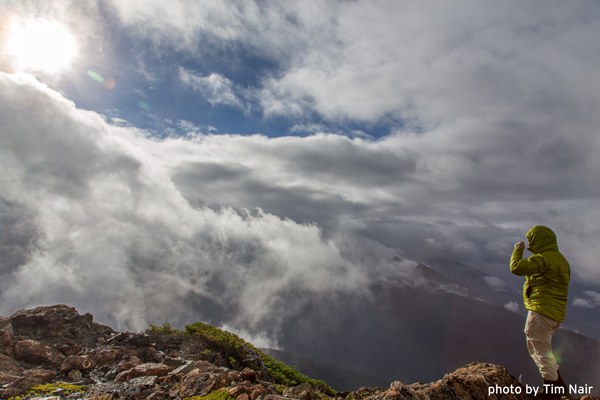
by Steve Scher
I remember the first mountain I climbed. Well, climbed is an overstatement — trudged is better. Dragged myself up is even more accurate.
We had hiked into the Mount Adams Wilderness and camped on a ridge across a valley from the mountaintop. We spent the night around the campfire, staring up into the bright stars and the dark outline of the peak. It wasn’t brooding or beckoning — it was just there — another part of this big planet, demanding it’s own kind of fealty.
I remember very little of the climb. I remember the sun. I remember that I wish I’d packed more food. Mostly I remember the ache in my chest and the weight of my boots.
As a kid, growing up in the Midwest, we encountered all kinds of snow. There was the light fluffy stuff — the powder you could kick and slide through. There was the crusty snow you could try to walk across. It usually cracked at some point and you’d plunge through to your thighs. And there was the thick, slushy stuff. In that stuff, every walk turned into a slog. Every time you lifted up your leg, you’d be lifting up a stalagmite of heavy, wet snow, mixed with dirt. It clung to yours boots. Then it would freeze. After awhile, you’re carrying a growing block of ice with each step.
That’s how I felt going up the side of Mount Adams. It felt like I was lifting up the whole mountain with every swing of my boot.
I never would have made it. The whole task just didn’t seem very important to me by that point. What did I care if I made it up a stupid mountain? This wasn’t worth it. I was hungry, my head hurt, I couldn’t lift my legs above the snow to take my next step. I might’ve turned back. I might’ve given up.
But I was climbing up with my friend Tim, and he wouldn’t have it. The whole point of the journey was to get to the top and so we would. We would make it. He joked, he cajoled, he berated, he laughed. He helped me to remember that I wanted to climb this mountain. And that it was up to me whether I got there or not.
And he just kept saying, “take another step. Take another step.” All the way to the top.
I’ve never forgotten that climb. It shaped me. I use it’s memory still. Take the next step, confront the pain, move through it.
The breakthrough comes in knowing; knowing yourself, knowing your path, knowing your abilities. That last is the tricky part. In knowing your abilities, can you know enough to challenge yourself, to push a little harder, to dig a little deeper, to find that additional ounce of energy. To stay committed to a journey that you’ve never taken before.
Finally, at the top of Mount Adams that long ago afternoon, we were in the fog. When we caught a glimpse of the sky, it was rolling with black cumulus clouds. There was no horizon, only a flat gray all around.
Then in an instant, the fog lifted, the clouds parted and one yellow shaft from the sun lit up the world. The brown and rumpled landscape of eastern Washington emerged in sharp relief, the world revealing itself anew. What a gift!
That’s how a personal breakthrough feels as well. You feel up against impossible odds, the world closing in, there seems no way forward — through a problem, out of a situation, up the mountain, and then, in a flash, you have a breakthrough. The path is clear, the strength to follow it renewed.
What brought you to it? How did you achieve it? There are all kinds of words to use: perseverance, fortitude, strength, luck. But for this story, I like a Zen concept — the wind finds many ways up a mountain.
The clouds closed back in on us that day and we were again enveloped in fog. The world again shapeless. But we had made it. We had that glimpse.
One of life’s lessons, offered up on the slopes of Mount Adam’s.
This article originally appeared in our March/April 2015 issue of Mountaineer magazine. To view the original article in magazine form and read more stories from our publication, click here.
 Steven Scher
Steven Scher